The Haswell Review: Intel Core i7-4770K & i5-4670K Tested
by Anand Lal Shimpi on June 1, 2013 10:00 AM ESTCPU Performance: Five Generations of Intel CPUs Compared
For the purposes of our look at Haswell, we will be breaking up our review coverage into two parts. The rest of this article will focus on the CPU side of Haswell, while coverage of the GPU - including Iris Pro and Crystalwell - has been spun off into another artice: Intel Iris Pro 5200 Graphics Review: Core i7-4950HQ Tested.
The majority of the market doesn’t upgrade annually, so I went back a total of five generations to characterize Haswell’s CPU performance. Everything from a 2.53GHz Core 2 Duo through Nehalem, Sandy Bridge, Ivy Bridge and Haswell are represented here. With the exception of the Core 2 platform, everything else is running at or near the peak launch frequency for the chip.
In general, I saw performance gains over Ivy Bridge of 1 - 19%, with an average improvement of 8.3%. Some of the performance gains were actually quite impressive. The 7.8% increase in Kraken shows there’s still room for improvement in lightly threaded performance, while the double digit FP performance gains in POV-Ray and x264 HD really play to Haswell’s strengths.
Compared to Sandy Bridge, Haswell looks even more impressive. The Core i7-4770K outperforms the i7-2700K by 7 - 26%, with an average performance advantage of 17%. The gains over Sandy Bridge aren’t large enough to make upgrading from a Sandy Bridge i7 to a Haswell i5 worthwhile though, as you still give up a lot if you go from 8 to 4 threads on a quad-core part running heavily threaded workloads.
Compared to Nehalem the gains average almost 44%.
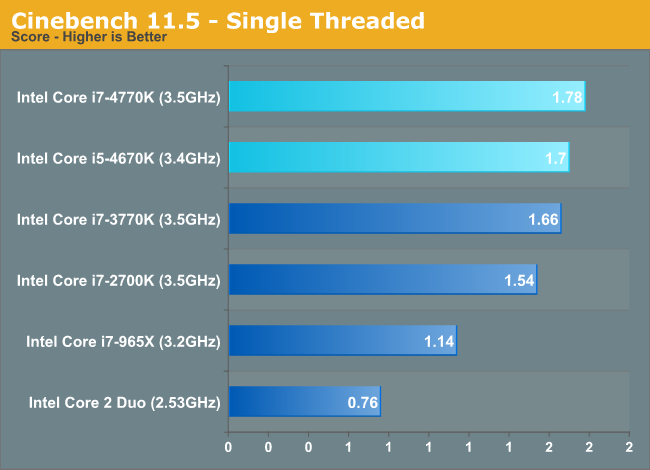


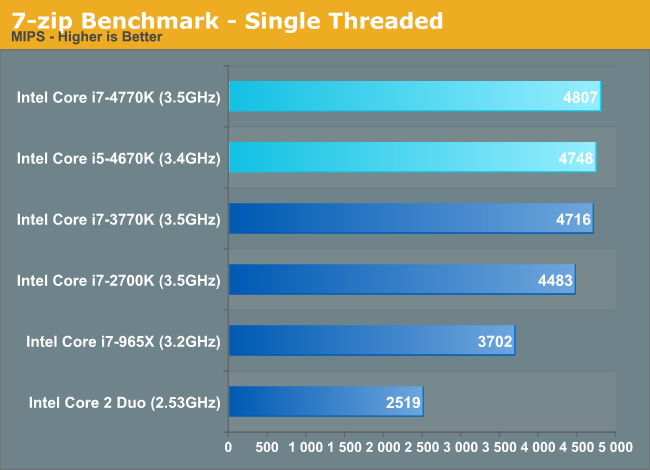
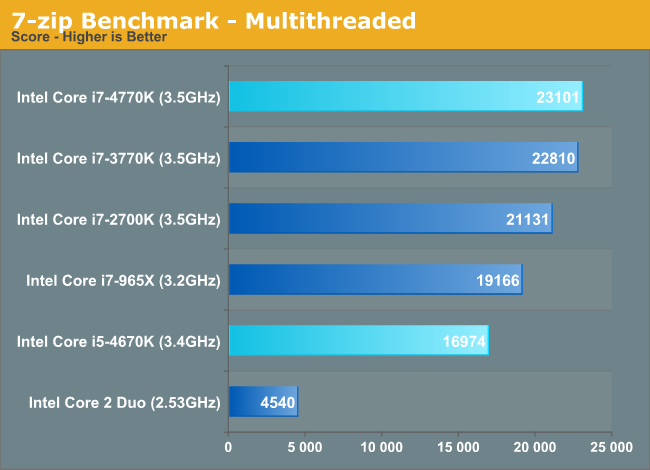
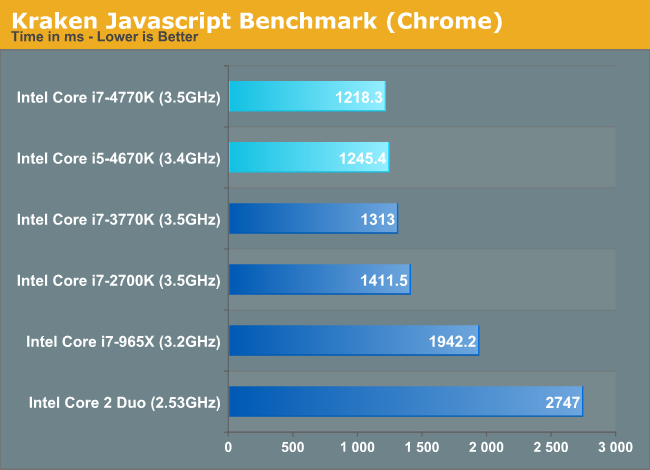
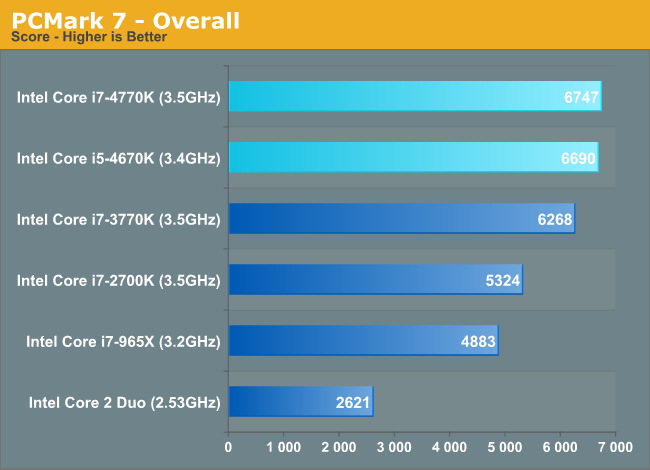
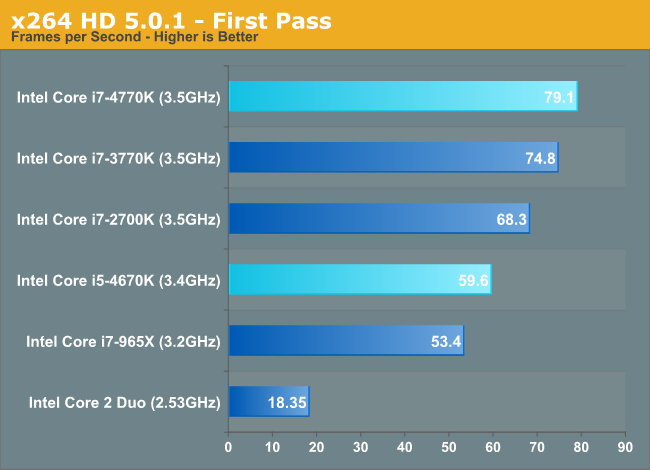
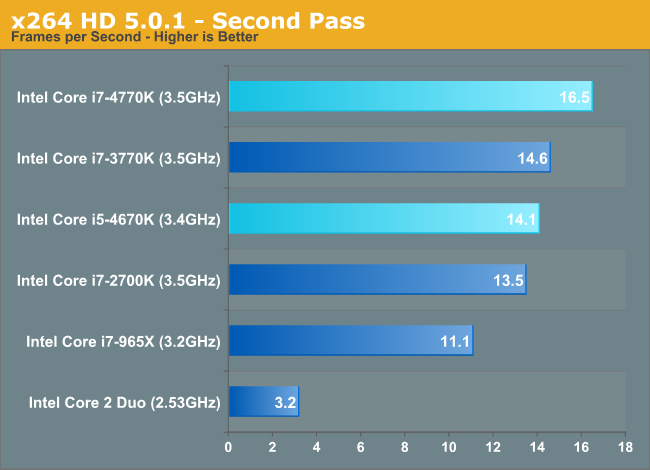
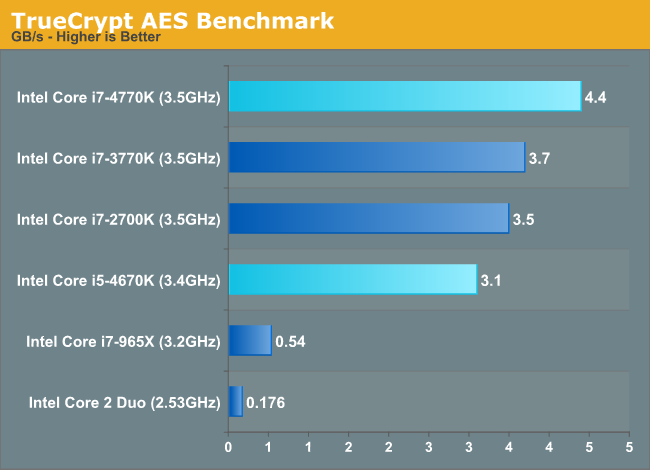

Quite possibly the most surprising was just how consistent (and large) the performance improvements were in our Visual Studio 2012 compile test. With a 15% increase in performance vs. Ivy Bridge at the same frequencies, what we’re looking at here is the perfect example of Haswell’s IPC increases manifesting in a real-world benchmark.
Gaming Performance
After spending far too much time on the Iris Pro test system, I didn’t have a ton of time left over to do a lot of gaming performance testing with Haswell. Luckily Ian had his gaming performance test data already in the engine, so I borrowed a couple of graphs.
As expected, Haswell is incrementally quicker in GPU bound gaming scenarios compared to Ivy Bridge - and most definitely at the top of the charts.
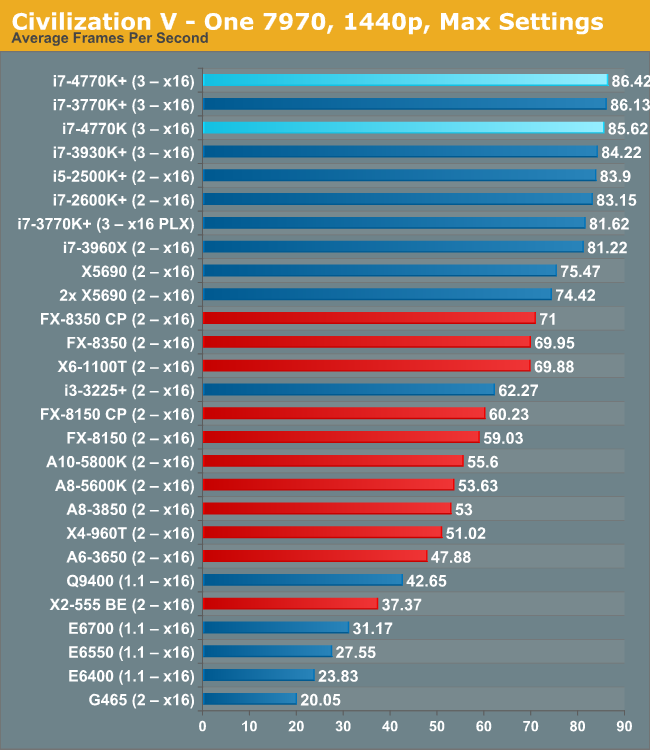











210 Comments
View All Comments
jeffkibuule - Saturday, June 1, 2013 - link
I wouldn't say that Pentium 4 was terrible, but their 2004-2006 exercise of continually pumping up clocks was misguided.Nfarce - Saturday, June 1, 2013 - link
Exactly. As someone who still has my P4 Northwood 3.06GHz (with HT) as a general use PC, I loved it. It served as my main gaming and photo/video editing PC back in the day, and was only replaced with a C2D E8400 overclock build four and a half years ago (which was replaced two years ago with a SB 2500k build). Anyone who says the P4 was terrible is either an AMD fanboy trolling or never had one at the time.bji - Saturday, June 1, 2013 - link
By any reasonable metric, P4s were pretty bad. Glad you like yours but that's mostly because even back in the P4 days CPUs were already "fast enough" most of the time for most tasks and you probably would have liked a Pentium M or Athlon just as well. P4s started out with very weak performance and were improved a decent amount during the lifetime of the architecture, but they were never spectacular performers vs. the competition and they were always extremely hot and power hungry. Also Rambus memory was a joke.More on topic, I'm not surprised that Haswell isn't significantly faster than Ivy Bridge. I said when Sandy Bridge came out that the x86 architecture would never get 50% faster per core than Sandy Bridge. With the combination of nearing the end of the road for process shrinking, the architecture itself already having been optimized to such a degree that any additional significant gains come at an extremely high transistor and R&D cost, the declining of importance of the x86 market as mobile devices become more prominent, and the "already much more than fast enough" aspect of modern CPUs for the vast majority of what they're used for, it's pretty clear that we'll never see significant increases in x86 speed again. There just isn't enough money available in the market to fund the extremely high costs necessary to significantly increase speed in a market where fast enough was achieved years ago.
I'll stand by my statement of ~2 years ago: x86 will top out at 50% faster than Sandy Bridge per core.
nunomoreira10 - Saturday, June 1, 2013 - link
Maybe not on the comon instruncion set, wich intel has already adress on haxwell, just wait for the software to update to avx2 and you will see how slow sandy bridge is by comparationklmccaughey - Monday, June 3, 2013 - link
@bji: Totally agree. We are in the halcion days and I can't see the likes of the 4770k getting significantly more powerful any time soon. I believe it will take a huge technology breakthrough in terms of fab materials, along the lines of optical or biological chips. At least 10 years away.The corollary to this is that we don't actually really need any more power. We already have the level of "good enough" for the GPU (in gaming terms). In terms of compute power, that is definitely continuing in the concurrency paradigm - which is where it should be, it makes sense. Programmers (like myself) are proceeding along these lines to get more power.
I think we are at either a pivotal point or a point of divergence again in computer technology. It's very exciting and interesting for me :)
jmelgaard - Sunday, June 2, 2013 - link
Wait what... I must be an AMD fanboy then (although I love Intel and never owned an AMD >.<, lol)...Honestly, the P4 platform was terrible in many aspects, and yes I did own one, several actually (2.266, 2.4, 2.8)... But having a Dual Pentium III 1GHz at the time as well made it pretty obvious to me how bad the P4 really was... Granted all those P4 was at lower clocks than yours...
But nothing is bad not to be good for something, after all intel's after the P4 generation has all been pretty amazing...
More in the topic though, I am a bit dismayed and disappointed that the power consumption goes up compared to the last generation under load... Great that the idle power goes that much down, but I would rather see the exact same performance as 3rd gen and a huge power reduction... After all, performance wise I am still over satisfied with my i970... I don't feel like i need more juice, so I would rather save some bucks on the electrical bill... Obviously there will be different minds about that part... Just saying what I feel...
Donkey2008 - Monday, June 3, 2013 - link
Weird how you keep saying how "bad" it was in it's time, yet you present no actual facts to back that up. About the only bad thing I ever saw with the P4 were high temps, which any decent HSF fixed.bji - Monday, June 3, 2013 - link
It was so bad that Intel had to pay vendors not to buy the competitor's chips, an action that they were later sued for and settled to the tune of $1.25 billion.The P4 started out very badly; it was very power hungry and had weak performance compared to the competition. Intel was also the only company able to make chip sets for it (can't remember if there were technical or legal reasons behind this or both), and they refused to support any memory but Rambus (for a long time), further hurting their cause by propping up a company that is pretty much the dregs of submarine patent lawsuit filth.
I can't think of any way in which the P4 was better than its competition of the day except that it had Intel's sleazy business practices behind it, if you consider that "better". It certainly played better in the marketplace, ethics notwithstanding.
You may have been happy with your P4 because it did what you needed it to do. Awesome. Nobody is saying that the P4 didn't work or that it couldn't actually fulfill the duties of a CPU, we're just saying that compared to its contemporaries, it kinda blew chunks.
superjim - Wednesday, June 5, 2013 - link
I had two P4 chips (2.4 Northwood and 3.0 Prescott) along with many Athlon XP systems (Palomino, Thoroughbred and Barton) and the Athlon's beat the P4s in nearly every metric. Then came the Athlon 64 to solidify AMD's crown. It wasn't until the original Core (Conroe) chips when Intel came screaming back and have held it since.Donkey2008 - Monday, June 3, 2013 - link
"Anyone who says the P4 was terrible is either an AMD fanboy trolling or never had one at the time. "+5
My Northwood 3GHz was as fast, stable and solid as any CPU I have ever owned. Performed slightly slower than an equivalent A64, but nothing noticable to the human eye. Maybe these people who bag on it have bionic eyes.